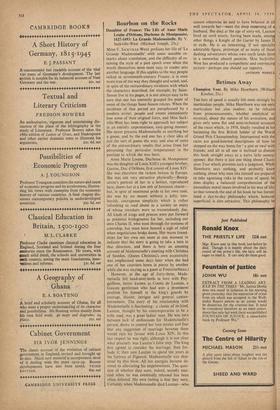Bourbon on the Rocks
Daughter of France: The Life of Anne Marie Louise d'Orlians, Duchesse de Montpensier, 1627-1693: La Grande Mademoiselle. By V. Sackville-West. (Michael Joseph, 25s.) Miss V. SACKVILLE-WEST prefaces her life of 'La Grande Mademoiselle' with some sensible re- marks about translation, and the difficulty of re- taining the style of a past epoch even when the words themselves seem most easy to render into another language. If this applies to the way people talked in seventeenth-century France, it is even more true of the way they thought and acted; and, in spite of the extraordinary vividness with which the characters described, for example, by Saint- Simon live in his pages, it is not always easy to be sure that one has correctly grasped the point of some of the things Saint-Simon relates. When the incidents of that period are paraphrased by a modern writer, people and events immediately lose some of their original force, and Miss Sack- ville-West has been right to approach her subject in an entirely unpretentious, easy-going manner. She never presents Mademoiselle as anything but a goose, and by the end one has a clear idea of just the sort of goose she was; and also of some of the extraordinary results that arose from her possessing that particular temperament in the position to which she was born.
Anne Marie Louise, Duchesse de Montpensier was the daughter of Louis XIII's youngest brother, Gaston, Duc d'Orleans, first cousin of Louis XIV. She was therefore the richest heiress in Europe. She was not very attractive physically—Bourg- uinon's portrait of her in a helmet, reproduced here, shows her at a low ebb of feminine charm— but, in spite of enormous pride in her own rank, she was by no means without a jolly, torn- boyish, courageous simplicity which is rather refreshing to read about in a society so many of whose members were so tremendously fine. All kinds of kings and princes were put forward as potential bridegrooms for her, including our own Charles II, who went through the motions of courtship, but must have heaved a sigh of relief when negotiations broke down. Her warm friend- ships for her own sex seem at one moment to indicate that the story is going to take a turn in that direction, and there is here an amusing account of Mademoiselle's meeting with Christina of Sweden. (Queen Christina's own eccentricity was emphasised some days later when she had one of her courtiers hewn in pieces by another while she was staying as a guest at Fontainebleau.) However, at the age of forty-three, Made- moiselle fell head-over-heels in love with Puy- guilhem, better known as Comte de Lauzun, a Gascon gentleman who had won , a prominent position for himself in the king's guards by courage, bluster, intrigue and general cantan- kerousness. The story of his relationship with Mademoiselle is fascinating: a classic of its kind. Lauzun, thought by his contemporaries to be a trifle mad, was a great ladies' man. He was torn between lack of enthusiasm for Mademoiselle's person, desire to control her vast estates and fear that any suggestion of marriage between them would ruin his favour with Louis XIV, In this last respect he was right, although it is not clear what precisely was Lauzun's false step. The king first agreed to consider the marriage; then for- bade it; then sent Lauzun to spend ten years in the fortress of Pignerol. Mademoiselle was shat- tered by this blow. All her energies became de- voted to alleviating his imprisonment. The ques- tion of whether they were, indeed, secretly mar- ried when he was eventually released has been often debated. My own feeling is that they were. Certainly when Mademoiselle died Lauzun—who cannot otherwise be said to haiie behaved at all well towards her—wore the deep mourning of a husband. She died at the age of sixty-six; Lauzun lived on until ninety, having been made, among other things, a Knight of the Garter by James II in exile. He is an interesting, if not specially admirable figure, prototype of so many of those dashing adventurers whose own myth lands them in a somewhat absurd position. Miss Sackville- West has produced a sympathetic and convincing picture—perhaps one should say tapestry.
ANTHONY POWELL














































 Previous page
Previous page